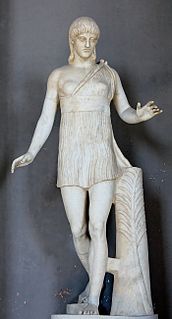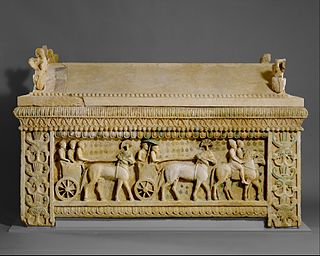Laodice, was a princess of Pontus and was one of the daughters of Mithridates II of Pontus and Laodice. Her sister was Laodice III, the first wife of Antiochus III the Great, and her brother was Mithridates III of Pontus. She married her distant maternal cousin, the Seleucid general Achaeus. When Achaeus fell into the power of Antiochus III, Laodice was left in possession of the citadel of Sardis, in which she held out for a time, but she was quickly compelled by the dissensions among her own troops to surrender to Antiochus III. Polybius incidentally mentions that she was brought up before her marriage at Selge, in Pisidia, under the care of Logbasis, a citizen of that place.

Pasiteles was a Neo-Attic school sculptor from Ancient Rome at the time of Julius Caesar. Pasiteles is said by Pliny to have been a native of Magna Graecia, and to have been granted Roman citizenship. He worked during a period where there was a demand for copies of, or variations on, noted works of Greek sculpture; the demand was met by the workshops of Pasiteles and his pupils Stephanus and Menelaus and others, several of whose statues are extant. According to Pliny, Pasiteles made an ivory statue of Jupiter for the temple of Metellus and made statues for the temple of Juno in the portico of Octavia.

Ariarathes VI Epiphanes Philopator, King of Cappadocia, was the youngest son of Ariarathes V of Cappadocia and Nysa of Cappadocia.

Idrieus, or Hidrieos was a ruler of Caria under the Achaemenid Empire, nominally a Satrap, who enjoyed the status of king or dynast by virtue of the powerful position his predecessors of the House of Hecatomnus created when they succeeded the assassinated Persian Satrap Tissaphernes in the Carian satrapy.

Aeaces is the name of two individuals from ancient Greek history:
Aetna was in Greek and Roman mythology a Sicilian nymph and, according to Alcimus, a daughter of Uranus and Gaia, or of Briareus. Stephanus of Byzantium says that according to one account Aetna was a daughter of Oceanus. Simonides said that she had acted as arbitrator between Hephaestus and Demeter respecting the possession of Sicily. By Zeus or Hephaestus she became the mother of the Palici. Mount Aetna in Sicily was believed to have derived its name from her, and under it Zeus buried Typhon, Enceladus, or Briareus. The mountain itself was believed to be the place in which Hephaestus and the Cyclops made the thunderbolts for Zeus.
Sangarius was a Phrygian river-god of Greek mythology. He is described as the son of Oceanus and Tethys and as the husband of Metope, by whom he became the father of Hecuba. He is also the father of Nana and therefore the grandfather of Attis. The Sakarya River itself is said to have derived its name from one Sangas, who had offended Rhea and was punished by her by being changed into water.
Agesipolis III was the 31st and last of the kings of the Agiad dynasty in ancient Sparta.
"Agoraea" and "Agoraeus" were epithets given to several divinities of Greek mythology who were considered to be the protectors of the assemblies of the people in the agora (ἀγορά), particularly in Athens, Sparta, and Thebes. The gods so named were Zeus, Athena, Artemis, and Hermes. As Hermes was the god of commerce, this epithet seems to have reference to the agora as the marketplace; a bronze statue of Hermes Agoraeus is mentioned as standing near the agora in Athens by both Aristophanes and Demosthenes.
Alagonia was a town of ancient Laconia, ancient Greece, near the Messenian frontier, belonging to the Eleuthero-Lacones, containing temples of the Greek gods Dionysus and Artemis. This town was 30 stadia distant from Gerenia.
Aulus Postumius Albus Regillensis was a patrician politician of ancient Rome, and apparently son of Aulus Postumius Albus Regillensis, and therefore brother of Spurius Postumius Albus Regillensis. He was consul in 464 BC, carried on war against the Aequians, and protected the border from raiders. Before the Battle of Mount Algidus he was sent as ambassador, along with Quintus Fabius Vibulanus and Publius Volumnius Amintinus Gallus, to the Aequians in 458 BC, on which occasion he was insulted by their commander, who told him to take Rome's entreaties and tell them to an oak tree.
Alea was an epithet of the Greek goddess Athena, prominent in Arcadian mythology, under which she was worshiped at Alea, Mantineia and Tegea. Alea was initially an independent goddess, but was eventually assimilated with Athena. A statue of Athena Alea existed on the road from Sparta to Therapne. Her most important sanctuary was the famous Temple of Athena Alea at Tegea.
In Greek mythology, Autesion – the son of Tisamenus, the grandson of Thersander and Demonassa and the great-grandson of Polynices and Argea – was a king of Thebes.
According to Herodotus, Labda was a daughter of the Bacchiad Amphion, and mother of Cypselus, by Eetion. Her name was derived from the fact of her feet being turned outward, and thus resembling the letter lambda (Λ), which, by the accounts of the most ancient Greek grammarians, was originally pronounced labda[labda].
Aulus Allienus was the name of two ancient Romans who lived roughly around the 1st century BC, and who may have been the same person:
Almo was in ancient Roman religion the eponymous god of the small river Almo in the vicinity of Rome. Like Tiberinus and others, he was prayed to by the augurs of Rome. In the water of Almo the aniconic stone embodying the mother of the gods, Cybele, used to be washed. He had a naiad daughter named Larunda.
The gens Herminia was an ancient patrician house at Rome. Members of the gens appear during the first war between the Roman Republic and the Etruscans, circa 508 BC, and from then to 448 BC. Two members of the family held the consulship, Titus Herminius Aquilinus in 506 BC, and Lars Herminius Aquilinus in 448.
Androtion was an ancient Greek writer on agriculture, who lived before the time of Theophrastus.
Derdas III was archon of Elimiotis in Upper Macedonia in 360–355 BC. He was probably a son of Derdas II. He had a brother named Machatas and a sister Phila, who was one of the first women Philip II of Macedon married.







